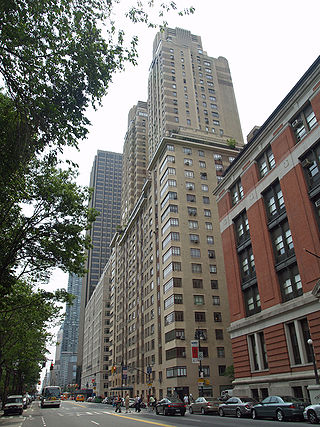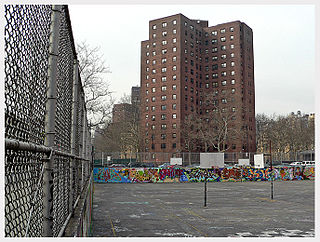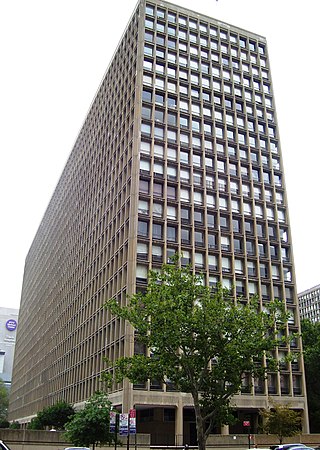
The Lower East Side, sometimes abbreviated as LES, is a historic neighborhood in the southeastern part of Manhattan in New York City. It is located roughly between the Bowery and the East River from Canal to Houston streets. Historically, it was understood to encompass a much larger area, from Broadway to the East River and from East 14th Street to Fulton and Franklin Streets.

Stuyvesant Town–Peter Cooper Village, sometimes shortened to StuyTown, is a large post–World War II private residential development on the east side of the New York City borough of Manhattan. The complex consists of 110 red brick apartment buildings on an 80-acre (32 ha) tract stretching from First Avenue to Avenue C, between 14th and 23rd Streets. Stuyvesant Town–Peter Cooper Village is split up into two parts: Stuyvesant Town, south of 20th Street, and Peter Cooper Village, north of 20th Street. Together, the two developments contain 11,250 apartments.
Frederick Fillmore French was a real estate developer active primarily in New York City. His largest developments include the Fred F. French Building, Tudor City, and Knickerbocker Village.

The Super is a 1991 American comedy film directed by Rod Daniel and starring Joe Pesci as a New York City slum landlord sentenced to live in one of his own buildings until it is brought up to code. Screenwriter Nora Ephron co-scripted the story with Sam Simon. The Super is the last film in which Vincent Gardenia appeared.

South Street is a street in Lower Manhattan, New York City, located immediately adjacent to the East River. It runs from Whitehall Street near the southern tip of Manhattan to Jackson Street near the Williamsburg Bridge. The Franklin D. Roosevelt East River Drive, in an elevated portion known as the South Street Viaduct, runs along the entire length of the street.

The Century is an apartment building at 25 Central Park West, between 62nd and 63rd Streets, adjacent to Central Park on the Upper West Side of Manhattan in New York City. It was constructed from 1930 to 1931 at a cost of $6.5 million and designed by the firm of Irwin S. Chanin in the Art Deco style. The Century is 30 stories tall, with twin towers rising from a 19-story base. The building is a contributing property to the Central Park West Historic District, a National Register of Historic Places–listed district, and is a New York City designated landmark.

Little Fuzhou is a neighborhood in the Two Bridges and Lower East Side areas of the borough of Manhattan in New York City, United States. Little Fuzhou constitutes a portion of the greater Manhattan Chinatown, home to the highest concentration of Chinese people in the Western Hemisphere. Manhattan's Chinatown is also one of the oldest Chinese ethnic enclaves.

21 West Street, also known as Le Rivage Apartments, is a 33-story building located in the Financial District of Lower Manhattan in New York City, on Morris Street between West Street and Washington Street. It was built in 1929–1931 as a speculative office tower development in anticipation of an increased demand for office space in Lower Manhattan. The building was converted into apartments in 1997 and was renamed Le Rivage.

The Boulevard Gardens Apartments is a 960-unit apartment complex at 54th Street and 31st Avenue in Woodside, Queens, New York City. It opened in June 1935, during the Great Depression. They were designed by architect Theodore H. Englehardt for the Cord Meyer Development Corporation; the design was based on an apartment complex Elgelhardt designed in Forest Hills.

Lincoln Towers is an apartment complex on the Upper West Side of the New York City borough of Manhattan that consists of six buildings with eight addresses on a 20-acre (81,000 m2) campus.

The University Village is a complex of three apartment buildings located in Greenwich Village in the Lower Manhattan-part of New York City. The complex is owned by New York University and was built in the 1960s as part of the university's transition to a residential college. One of the towers, 505 LaGuardia Place, is a co-op that does not house students, and the other two towers, Silver Tower I and Silver Tower II, house faculty and graduate students of NYU. The buildings were designed by modern architects James Ingo Freed and I. M. Pei, and the central-plaza contains a sculpture by Carl Nesjär and Pablo Picasso. In 2008 the complex was designated a New York City Landmark by the Landmarks Preservation Commission.

The John Haynes Holmes Towers is a public housing project for low income residents of the Yorkville section of the Upper East Side located just south of the neighborhood's northern limit at 96th Street, in New York City, New York, United States. The neighboring Isaacs Houses and the Holmes Towers border East Harlem, which has the second highest concentration of public housing in the United States. The two public housing buildings, designed by Architects Eggers and Higgins, were completed in 1969, are 25 stories tall and contain 537 apartments. The project is located between 92nd and 93rd Streets from 1st Avenue to York Avenue and the FDR Drive.

Bernard M. Baruch Houses, or Baruch Houses, is a public housing development built by the New York City Housing Authority (NYCHA) on the Lower East Side of Manhattan. Baruch Houses is bounded by Franklin D. Roosevelt East River Drive to the east, E. Houston Street to the north, Columbia Street to the west, and Delancey Street to the south. The complex, the largest NYCHA development in Manhattan, occupies 27.64 acres (111,900 m2), of which buildings cover 13.4%, a percentage similar to that of most "tower in the park" project designs. It has 2,194 apartments, which house an estimated 5,397 people. These apartments are distributed throughout 17 buildings. Baruch Houses I is seven stories tall, Baruch Houses XI, XIII, and XV are thirteen stories tall, and the rest are fourteen stories tall. Combined, these buildings have 2.9 million square feet (270,000 m2).

Carver Houses, or George Washington Carver Houses, is a public housing development built and maintained by the New York City Housing Authority (NYCHA) in Spanish Harlem, a neighborhood of Manhattan.

Kips Bay Towers is a large two-building condominium complex in the Kips Bay neighborhood of Manhattan with a total of 1,118 units. The complex was designed by architects I.M. Pei and S. J. Kessler, with the involvement of James Ingo Freed, in the brutalist style and completed in 1965. The project was developed by Webb & Knapp.

South Jamaica Houses is a housing project in South Jamaica, Queens, New York. It is nicknamed "40 Projects." The original complex, South Jamaica I Houses opened in 1940, while the second complex, South Jamaica II Houses, opened in 1954. The entire complex is bounded by South Road to the north, 160th Street to the east, Brinkerhoff Avenue to the south, and 158th Street to the west.

Essex Crossing is an under-construction mixed-use development in New York City's Lower East Side, at the intersection of Delancey Street and Essex Street just north of Seward Park. Essex Crossing will comprise nearly 2,000,000 sq ft (200,000 m2) of space on 6 acres and will cost an estimated US$1.1 billion. Part of the existing Seward Park Urban Renewal Area (SPURA), the development will sit on a total of nine city blocks, most of them occupied by parking lots that replaced tenements razed in 1967.

The Rockefeller Apartments is a residential building at 17 West 54th Street and 24 West 55th Street in the Midtown Manhattan neighborhood of New York City. Designed by Wallace Harrison and J. André Fouilhoux in the International Style, the Rockefeller Apartments was constructed between 1935 and 1936. The complex was originally designed with 138 apartments.



















